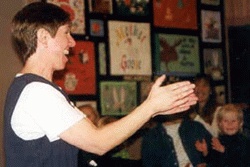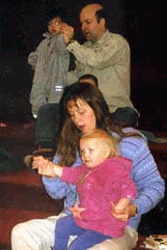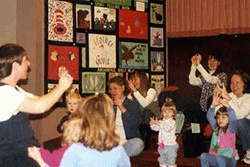| My 2-year-old friend, Sadie Oswald, lured me to Lapsit this fall. I first caught her enthusiasm when she ran barelegged about her house, clutching her stuffed animal, Ollie, and saying, "Amy, Amy, Amy, Amy!" She wasn't referring to me (I'm "Amy C.") but to Amy Johnson, Youth Services Librarian, who has become a family name. Sadie's Ollie is a worn-out replica of Amy's Ollie, a stuffed otter puppet who perches on Amy's hand and greets children at Loussac Library's stage as they arrive for Lapsit. Ollie also accompanies Amy during the session, which is a 25-minute block of story-time and group singing.
 |
| Amy Johnson claps as children and parents sing. |
 |
Amy Johnson is certainly the personality behind Lapsit -- a personality children relate to. Amy and Ollie hold up the books and read with animated voices, hands, feet, and faces. Since the books tend to be repetitive, often by the end the children can guess some of the words. Small gasps and giggles escape when this happens. Amy follows her own advice, which is: "Read in a lively way. Alternate things like speed, volume, and rhythm, so it is interesting. And remember, you don't have to have a perfect voice. I get off tune all the time. It's good for them to see that it's not the most important thing -- that sharing is most important." Amy has this advice for parents and caregivers: When you are reading to your children, use a variety of materials, but don't be afraid to repeat materials over and over, especially if your child asks for a particular book. Also, don't worry about missing a word, and having to go back -- it demonstrates that it's okay to make mistakes, and that the most important part is in the process. But if Amy makes mistakes, it is missed by her Lapsit audience, which consists of toddlers up to age 3, and their parents, guardians, and friends, who bring the room to life with their singing and dancing.
 |
| Parents and children sing at Lapsit. |
 |
Everyone at Lapsit gets a pamphlet about the program, which includes the words to the songs. Parents often read along, and toddlers sometimes hold the pamphlets with pride. "Short stories, simple fingerplays, songs, and nursery rhymes combined around a central theme give your child an opportunity to learn new ideas and to develop better listening skills and behavior," the pamphlet explains. "By using activities that are repetitive, children are given the opportunity to learn at their own pace, encouraging participation."
Lapsit is designed to be an introduction to books, focusing on the reading portion of language development. Amy says, "Children learn how to open a book, move their eyes from left to right, turn pages … the symbols on the pages have to do with pictures. They learn the sound of letters, the way a book is read, the sharing of stories. It moves them towards reading readiness. They've learned how to handle books and they've heard so many words and built their vocabulary so that they are becoming ready to read on their own. But also, they have the chance to be in a group setting, and so Lapsit also aims at social development. They see what kinds of behaviors other people have -- other children but adults too. They develop attention span, patience, and practice interacting -- sharing, being in a room with adults who aren't their parents. For many this is their first group setting."
 |
| Amy Johnson leads Lapsit participants in a fingerplay. |
 |
"Lapsit also has the dual role of involving children and parents," says Amy. Parents have the opportunity to meet one another, share information about their communities, children, and books. "And also, for some parents, it's a good example of someone modeling reading to children." Many parents already read to their children, but for some this is an introduction and an excellent way of learning tips on how to do it well.
To join Amy and other librarians in your town, contact your local library and ask for a schedule of their reading sessions. The Samson-Dimond Library, the Loussac Library, and the Eagle River and Girdwood branches of the Loussac all offer a variety of drop-in sessions for children and their families.
|
 |
|




